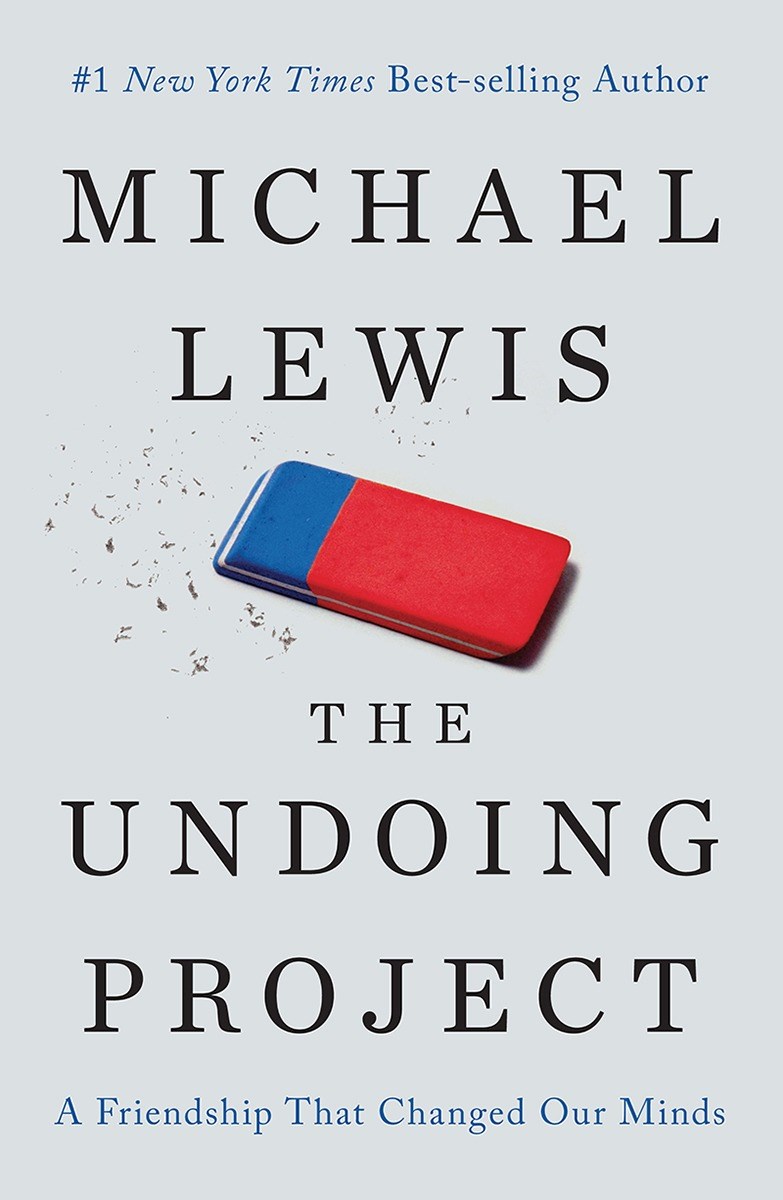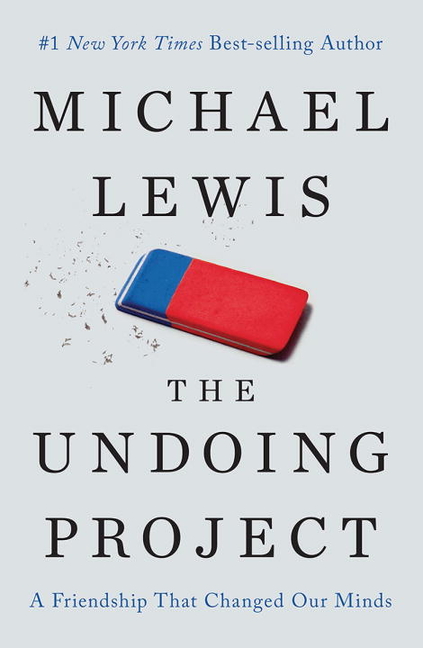The Undoing Project: A Friendship That Changed Our Minds
December 08, 2016
Michael Lewis has delivered what may be his best book yet, one he seems predestined to have written—if only that were a logical possibility.

The Undoing Project: A Friendship That Changed Our Minds by Michael Lewis, W.W. Norton & Company, 368 pages, $28.95, Hardcover, ISBN 9780393254594
Not a month goes by in my sifting through business books that I don't find reference to Daniel Kahneman and Amos Tversky’s theories and ideas, either filtered or directly from the source, in lessons about decision making, management, human behavior. The very study of behavioral economics begins with their insights, and their work together has left its fingerprints in all corners of the genre we work in.
Michael Lewis, a giant of the genre himself, was introduced to the work of Kahneman and Lewis through a review of his landmark book, Moneyball, by another dynamic duo, Cass Sunstein and Richard Thaler. They commented in a review in New Republic that, while his exploration of the market inefficiencies in baseball talent evaluation was indeed interesting, Lewis seemed to be unaware of the underlying psychological reasons for it—reasons that had been explored in depth by Daniel Kahneman and Amos Tversky. Lewis understood then and there that, while he had brought many of the biases that made markets inefficient to light for a popular audience, he had only scratched the surface of a vast sea of thought that had been pioneered before him:
I’d set out to tell a story about the way markets worked, or failed to work, especially when they were valuing people. But buried somewhere inside it was another story, one that I’d left unexplored and untold, about the way the human mind worked, or failed to work, when it was forming judgments and making decisions.
Michael Lewis’s exploration was just beginning. It turned out the work of two Israeli psychologists held the key to unlocking those unexplored depths, and in a strange twist of fate, Lewis found out that Daniel Kahneman now lived in the hills of Berkeley above him, and he had mutual friends that could make an introduction. Not only that, he had taught Amos Tversky’s son at the University of California in the one course he’d taught there, and ended up getting access to that great man's meticulously kept papers. Through his friendship with Danny, access to Amos’s papers, and eight years of hard work, The Undoing Project took shape.
Lewis begins the book with a 30-page digression into the analytical revolution taking place in talent evaluation in the NBA, something that Amos Tversky, an avid basketball fan, would have surely loved. Yet, while it adheres closely to both Amos’s passion and the "moneyball" phenomenon, it seems a somewhat curious place to start, until…
Twenty-five pages later, after an account of a childhood spent being hunted by Nazis and their sympathizers in the French countryside, we find Danny Kahneman, at just twenty-one years old, tasked with coming up with a way to assess the fitness and talents of conscripts into the Israeli Army. As a largely self-taught psychology graduate of Hebrew University (which didn’t really have a psychology department to speak of at the time because the man that had been recruited to develop it was killed in an ambush years before Kahneman arrived), he developed an interview process so successful in bringing order to the Israeli armed forces that it is still being used today. In a foreshadowing of work to come, the key to that process was removing, as much as possible, human judgment and bias.
Amos Tversky was a native Israeli, a war hero, and in many ways the opposite of Kahneman—self-confident where Kahneman was self-doubting, outgoing where Danny was introverted. Most who met him thought he was the smartest man they’d ever met. By the late 1960s, he and Kahneman were the two shining lights of the psychology department at Hebrew University, but they were two distinctly separate lights. Some suspected a rivalry, but it was more likely a lack of real encounter between the two. Then, in the spring of 1969, Danny invited Amos to speak to his class. Afterward, according to a friend of Amos, Danny told him:
“Brilliant talk, but I don’t believe a word of it.”
You see, Kahneman didn’t only doubt himself. He doubted all knowledge, all theory. And in that environment, his doubt and disbelief wasn’t a matter of opinion. “The idea that everyone is entitled to his/her opinion,” Kahneman tells Lewis, “was a California thing—that’s not how we did things in Jerusalem.” This was science, and one of them had to be right. There was a lot of dialogue in Israeli between academics, civil society, and the security apparatus. Their work was being discussed and often implemented by a young state still very unsure of its own prospects for security and survival.
I got the feeling from reading Lewis’s account that Kahneman’s disbelief in the seminar was a challenge that sparked an intellectual crisis in Tversky. And that doubt led him back to Kahneman full of questions, sparking conversations that would turn into a deep collaboration. Soon, they’d be practically inseparable, spending their days in a meeting and melding of minds behind closed doors from which heated arguments and lots of laughter—especially the laughter—emanated. Their minds seemed to work differently, and more efficiently, together. They questioned themselves, each other, and the very foundations of the academic discipline they were immersed in, and found ways to test their ideas on their colleagues. In the process, it is as if they discovered just how wrong they all were about everything, and found it almost unbearably hysterical. Lewis even writes that they “half-thought” of their first paper “as a joke played on the academic world.”
Their intellectual love affair lasted over a decade before they broke up. Without it, we wouldn’t know the significance (or lack thereof) of small sample size. We wouldn’t understand the insidious power of hindsight bias, and how it can convince us that we’re more intelligent and intuitive about events than we really are. We wouldn’t be able to consider our own cognitive biases and adjust for them. We wouldn’t have the word heuristics, or know what a foundational role they play in every decision we make. We would not have the insight that we attempt to minimize potential regret, rather than maximize potential utility, when making decisions and what a deleterious affect that may have on our lives and organizations.
Daniel Kahneman longed to do what he called “the psychology of single questions.” Together, he and Tversky tested and answered so many of those that a field emerged. They didn’t change the nature of how we think. That may not be possible. What they did was change how we think about how we think, exposing the flaws and inherent, predictable irrationality of it. Their insights have changed the way we make decisions everywhere from the baseball field to the battlefield.
It was a working relationship and loving friendship that was formed as a nation formed. It was work that had the weight of their nation’s existence on it at the beginning. It brought Danny out of the academy and into the real world, and took Tversky in the other direction. It seems almost predestined that Michael Lewis would end up writing this story, but that would suggest that we live in a deterministic world, a notion that would be rejected by them all.
Lewis’s writing is like a soft blanket that pulls you into sleep even when you don’t think you’re tired. Couched in his prose and storytelling ability, and in the desire to get to know the characters he’s introduced us to, he teases our intellectual curiosity and pulls us effortlessly into topics we might not think we’re interested in, leaving us with an education about two intellectual giants of the 21st century, and about ourselves.
The Undoing Project is an explanation of Kahneman and Tversky's incredible work, and of its importance, wrapped in an intense intellectual love story. It boggles the brain, and breaks the heart, and strengthens both muscles in the process.


